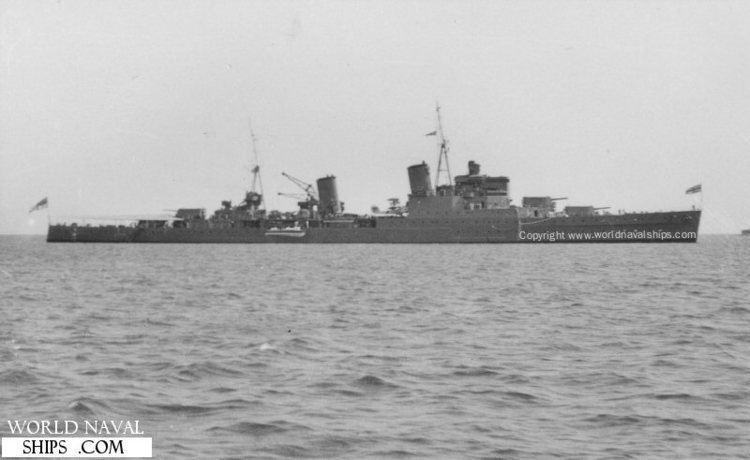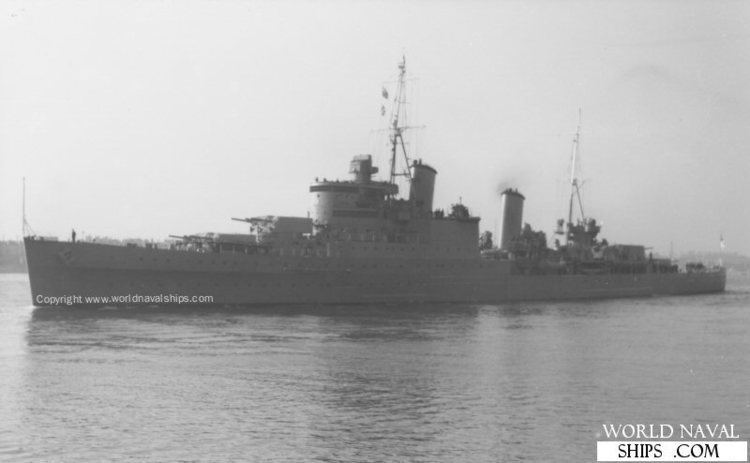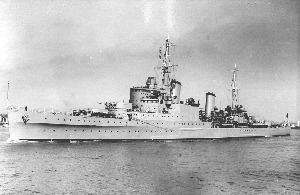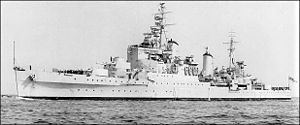Commissioned 9 September 1937 Launched 20 June 1936 Draft 6.55 m | Laid down 16 April 1935 Decommissioned November 1956 Construction started 16 April 1935 Length 170 m | |
 | ||
Fate Sold for scrap, July 1958 | ||
The seventh HMS Glasgow, built on the Clyde, was a Southampton-class light cruiser, a sub-class of the Town-class and commissioned in September 1937. She displaced 11,930 tons and had a top speed of 32 knots (59 km/h). She was part of the 2nd Cruiser Squadron of the Home Fleet; she escorted the King and Queen to Canada in 1939. She also took a large quantity of gold to Fort Knox as an emergency reserve.
Contents

Norwegian Campaign

Captain Frank Pegram was commanding officer of Glasgow from July, 1939 to April, 1940. On the outbreak of war, she operated off the Scandinavian coast, and in November was off the coast of Norway with two destroyers in the hope of intercepting the German passenger ship SS Bremen which had sailed from Murmansk. This was unsuccessful, but on 12 February 1940, she captured the German trawler Herrlichkeit off Tromsø. On 9 April, she was attacked off Bergen by Ju 88s and He 111s and damaged by near misses. On 11 April 1940, during the Allied campaign in Norway in World War II, Glasgow, along with HMS Sheffield and six Tribal-class destroyers landed troops near Harstad and three days later on 14 April, again in company with Sheffield and ten destroyers, landed an advance force of Royal Marines at Namsos to seize and secure the wharves and approaches to the town, preparatory to the landing of a larger Allied force. On 23 April Glasgow, Sheffield, HMS Galatea and six destroyers landed the first part of the 15th Infantry Brigade in Åndalsnes.

On 29 April, she evacuated King Haakon and Crown Prince Olav of Norway, Nygaardsvold's Cabinet and part of the Norwegian gold reserves when they fled from Molde to Tromsø, escaping the advancing German forces. She then departed to the United Kingdom on 1 May, carrying among others the Minister of Foreign Affairs Halvdan Koht and the Minister of Defence Birger Ljungberg.
The Mediterranean

Whilst operating in home waters after the withdrawal from Norway, Glasgow accidentally rammed and sank the destroyer HMS Imogen in thick fog off Duncansby Head on 16 July.

Glasgow was then employed as a convoy escort in the Mediterranean and as a reinforcement of the 3rd Cruiser Squadron based at Alexandria. She took part in the Fleet Air Arm raid that crippled the Italian Fleet at Taranto; on 14 November, Glasgow, along with Berwick, HMAS Sydney and HMS York, landed 3,400 troops from Alexandria in Piraeus. On 26 November, Glasgow, HMS Gloucester and York escorted a supply convoy from Alexandria to Malta. On 3 December Glasgow was attacked by Italian aircraft while anchored in Suda Bay, Crete. She was hit by two torpedoes fired by Carlo Emanuele Buscaglia and badly damaged. She was able to return to Alexandria, where rudimentary repairs were carried out. During this period she was temporarily replaced by HMS Southampton.
The Far East
On 12 February 1941 Glasgow left Alexandria and passed Suez Canal. On 18 February she joined East Indies Fleet at Aden. In February the German cruiser Admiral Scheer sank the freighters Canadian Cruiser and Rantaupandjang in the Indian Ocean. Both managed to transmit distress signals, that were picked up by Glasgow, which deployed in search of the German ship. On 22 January, Admiral Scheer was sighted by the spotter aircraft from Glasgow, the East Indies Task Force was deployed to the reported area. However, Admiral Scheer had escaped by turning away to the southeast and further searches were in vain. In March Glasgow, in company with HMS Caledon, two auxiliary cruisers, two destroyers and two anti-submarine trawlers of the Indian Navy, escorted two troop transport vessels containing two Indian Battalions and one Somali commando detachment, who were landed on either side of Berbera, in Somaliland, which had previously been occupied by the Italians. The town was taken after only slight Italian resistance, which was soon broken by naval gunfire from Glasgow and the other escorts. At midnight on 9 December 1941, Glasgow sank the RIN patrol vessel HMIS Prabhavati with two lighters in tow en route to Karachi, with 6 inch shells at 6,000 yards (5,500 m). Prabhavati was alongside the lighters and was mistaken for a surfaced Japanese submarine. Glasgow picked up the survivors and took them to Bombay, arriving there later that day.
On 19 March 1942, Glasgow escorted convoy WS-16 from the UK to South Africa. In April Glasgow again underwent temporary repairs, this time in Simonstown, South Africa. She subsequently sailed to the US for permanent repairs, which were completed in August. She then returned to the UK and joined the 10th Cruiser Squadron at Scapa Flow, where she was assigned to the covering forces of the Arctic convoys.
In the Arctic and home waters
Glasgow escorted Arctic convoys between January and February 1943. In March she intercepted the German blockade runner Regensburg in the Denmark Strait. Her crew managed to scuttle the ship and Glasgow recovered six survivors. During June and July she supplied cover for escort groups in the Bay of Biscay. She then joined the Plymouth Command.
In December 1943 she formed part of Operation Stonewall, (the interception of blockade runners).
In late December, Glasgow and the cruiser HMS Enterprise in the Battle of the Bay of Biscay fought a three-hour battle with eleven German destroyers and torpedo boats of which three were sunk and four damaged by gunfire. After this engagement Glasgow returned to Plymouth in spite of several air raids where glider bombs were used.
On 6 June 1944 Glasgow was part of Operation Neptune, (the Normandy landings). Along with the battleships USS Texas and USS Arkansas, the French cruisers Montcalm and Georges Leygues, nine US destroyers and three Hunt-class destroyers, she made up the Gunfire Bombardment Support Force C for Omaha Beach. On 25–26 June, in support of the attack by the 7th US Corps on Cherbourg, she shelled the German batteries near Querqueville. During this exchange of fire Glasgow was hit and damaged. In August 1945 she set sail for the East Indies, where she was the flagship of the Commander-in-Chief.
Postwar
In 1948 Glasgow was transferred to the West Indies and was again the flagship of the fleet, returning to the UK in 1950. In 1951 she was the flagship of the Mediterranean Fleet based at Malta under Admiral the Earl Mountbatten of Burma. In 1953, she took part in the film Sailor of the King. In the same year she took part in the Fleet Review to celebrate the Coronation of Queen Elizabeth II. In August 1954 Glasgow and HMS Gambia participated in the withdrawal of the Royal Marine Commandos. In 1955 Glasgow returned to the UK where she rejoined the Home Fleet as Flag Officer D, but was later paid off. The Suez crisis in 1956 caused Glasgow to be temporarily recommissioned, but later that year she was paid off again. It was then decided that she was surplus to requirements and was placed on the disposal list in November 1956. In July 1958 Glasgow was broken up at Blyth by Hughes Bolckow.
